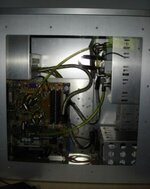Radical_53 [HWLUXX] schrieb:
Wieso bremst er den Durchfluß denn sehr? Ein Netzradi bremst den Durchfluß sicher nicht großartig. Ich denk da kann ich auch bald anschaulichere Werte zu liefern...
Ich habe keinen Durchflußdruckmesser. Aber der Durchfluß ist nicht hoch. Ich musste meine neue Laing DDC auch wieder zurück an den Händler schicken, sie hakte, wenn man sie etwas neigte und bei 50 Grad Neigung blockierte sie ganz. Kann also auch an der Pumpe liegen, daß mein Durchfluß schlecht ist. Aber ich habe keinen von diesen Durchflußbremsern a la Nexxos XP in der Revision 1.
Deshlab hatte ich mal genauer auf die Druckabfallwerte bei Radiatoren geschaut. Manche meinen bei Radis gibts da keine Probleme, andere behaupten das Gegenteil.
Und als ich die Werte von den Nexxos Extremes auf den neuen Teststand von WCP sah, kriegte ich ein Schock. 2/3 bei einer AP900!
Hatte das aber falsch verstanden. Der linke Wert ist vor dem Testobjekt und der rechte Wert nach dem Testobjekt. Das der linke Wert auch höher ist, wenn das Testobjekt einen hohen Widerstandswert hat, wuaste ich nicht. Ich habe nur auf die Werte des aktiven und passiven Radiatoren geschaut und da wa der rechte Wert immer bei 0.03 bis 0.04 und ich dachte das ist Konstant bei deren Testaufbau so.
Habe da aber noch etwas Interessantes zum AC Airplex Evo auf over-clocker.com gefunden:
"The Aqua Computer Evo radiators are coiled copper tubing designs. They are
used most frequently in conditions that require high pressures, such as
refrigeration condensors. While the coiled tube is great for operating well
under low-flow conditions, it is bulky and consumes up a lot of the body of
the finned area in comparison to a heater-core style radiator. Additionally,
the spacing between the tubes and the fins in the coiled tube radiators makes
for a less than optimal setup with respect to the conduction distance.
I suppose a good analogy is that while the looping tube style radiators are
good for liquid-metal heat transfer, they are generally far less efficient at
metal-air heat transfer when given the same space and size constraints.
Heater-core style radiators come close to as good as it gets for metal-air
efficiency, and provided you give them sufficient flow rate for their internal
design (single pass, multi-pass, whatever) the liquid-metal efficiency can be
as good as the looping tube style radiators. Heater-cores fall down though
more quickly at lower flow rates than the looping tube style radiators. Given
the historically low flow rates that occur in Teutonic systems, the looping
tube style radiators make a fair degree of sense.
It's a case of horses for courses. Looping tube can work better at
very-low-flow rates, while heater-cores (and heatercore style rads - Marci)
tend to work better at low-moderate flow rates and higher."
Demnach ist mein AC AEvo nicht schlecht, solange ich keine Laing DDC habe, aber ich gebe die Hoffung auf eine gute Laing DDC nicht auf...



 ).
). , wenn ich die Aquatube verbanne können die LW´s auch bissle weiter runter und der BI Radi hat mehr Luft.
, wenn ich die Aquatube verbanne können die LW´s auch bissle weiter runter und der BI Radi hat mehr Luft.


 Der Radi braucht im Gehäuse verbaut nach oben (außen) Platz, um frische Luft zu bekommen, und unten (im Gehäuse) Platz, um sie weg zu kriegen. Wenn er das auf einer Seite nicht hat, geht die Leistung zurück.
Der Radi braucht im Gehäuse verbaut nach oben (außen) Platz, um frische Luft zu bekommen, und unten (im Gehäuse) Platz, um sie weg zu kriegen. Wenn er das auf einer Seite nicht hat, geht die Leistung zurück.



